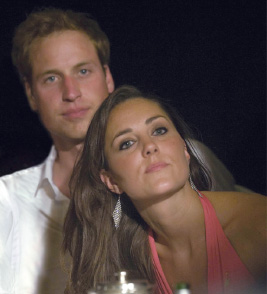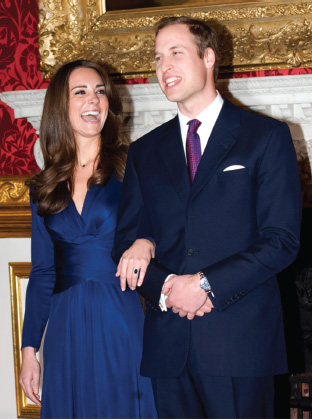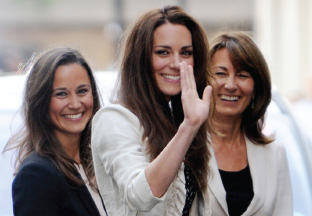Kate (29 page)
Authors: Katie Nicholl

It wasn't the only break with tradition. William and Kate wanted a “historic but modest” wedding. Kate wanted to arrive at Westminster Abbey by car rather than in the state coach, and at the couple's request, and in keeping with their wishes to be relatively frugal, it was decided that extended members of the royal family and visiting royals were to be ferried from Buckingham Palace to the abbey in minibuses. They also
wanted it to be a wedding for the people, so fifty of the couple's guests were drawn by lots from the charities they supported and invited to the ceremony in the abbey. They decided not to have a traditional wedding gift list and instead asked for donations to twenty-six charities that they hand-picked, among them an antibullying organization, Beat Bullying, that Kate personally wanted to support. It was a cause close to her heart ever since her painful experiences as a teenager at Downe House. The charitable fund was hugely popular, and members of the public helped to raise over $1 million for the couple's chosen causes.
William and Kate had asked Pippa to be the maid of honor and Harry to be best man, and the two of them were in charge of planning the evening party. Meanwhile, Kate was busy meeting with florists, cake makers, and the clergy. As part of her marriage preparations, she was confirmed into the Church of England. Although she had been baptized at birth, the Middletons were not regular churchgoers and Kate had never been confirmed. William and Kate, as future King and Queen of Great Britain, would be the heads of the Church of England one day, so they were expected to attend church every Sunday. Religion is embedded in the royal family, members of which until recently were not allowed to marry Catholics in order to preserve the Church of England faith, which was established in the sixteenth century by King Henry VIII. Kate was baptized at St. James's Palace in a private ceremony in March, to which only her family and William were invited.
There were top-secret dress fittings and clandestine trips to Hampton Court Palace, where the lace for her bridal gown was being hand-stitched by a team of seamstresses. The Palace had hired Anthony Gordon Lennox, a voice coach who was
helping to prepare Kate for the wedding day. He used breathing techniques to help her relax and taught her how to project her voice so that it would fill the abbey. One of the exercises she was required to do was record herself on video camera and watch the footage to see how she came across.
Wedding fever had not only gripped the nation, but the world. An advertisement for one mobile phone company featured a spoof of the wedding day, complete with royal look-alikes, which became a YouTube sensation. William and Kate apparently downloaded it, finding it “hilarious,” according to their friends. Meanwhile, in America, countless documentaries were made about Kate's rags-to-riches life, and her romance with William was deemed such a fairy tale that a feature-length movie was made about their university romance. The royal palaces in England and Scotland reported a record number of visitors. Westminster Abbey was busier than ever, with queues to get in, and thousands of street parties were being planned around the country for the wedding day itself. Official merchandise such as tea towels and commemorative bone china was hugely popular, festive bunting sold out, and Michael and Carole's website Party Pieces enjoyed weeks of bumper sales. The site had launched a “British Street Party” range of goods, which was selling well. It seemed everyone wanted to cash in on the wedding or anything to do with Kate. The see-through skirt that she wore in the St. Andrews fashion show where she famously caught William's eye was sold at auction for $118,000. The designer had vowed never to sell a “part of fashion history,” but when a mystery bidder offered to pay in cash, she capitulated.
The official Royal Wedding website received thousands of hits every day. The engagement pictures, which had been shot
by Diana's favorite photographer, Mario Testino, had been posted on the site, along with pictures from the Middleton family album of a three-year-old Kate rock climbing in the Lake District and visiting Petra in Jordan. The fact that Kate had spent her early childhood in the Middle East had only just become public knowledge.
Behind the scenes, Michael and Carole were in constant contact with the Palace. Historically, in-laws have always been kept at an arm's length, but in this case the Middletons were being allowed to contribute to the wedding, together with the Queen and Prince Charles. William had promised Michael and Carole they would always be included in their lives and his in-laws wanted to make a financial contribution. It was quite unprecedented. When Lady Diana Spencer and Sarah Ferguson married into the royal family, their families complained bitterly at being left out in the cold once their daughters married into royalty.
Carole and Michael were kept abreast of developments as the wedding took shape through a hotline to the St. James's Palace Press Office. Courtiers appreciated that, not coming from nobility, the Middletons might need some help navigating through all the rigmarole and protocol of a royal wedding. They were an ordinary family thrust into a most extraordinary situation, and there were a number of adjustments to be made to their lives within a relatively short space of time. The Middletons had already faced accusations in the press that their business was shamelessly cashing in on the royal wedding by stocking themed memorabilia. Carole called Mr. Lowther-Pinkerton for advice. When Britannia-themed scratch-cards complete with crownsâwhich were deemed rather tacky and in poor taste by some sections of the mediaâwent on sale on the
site, aides suggested withdrawing the products, which were then discontinued online. Michael and Carole found themselves in a difficult position: they had a business to run and a team of staff to employ, and everyone else was making a pretty penny out of the royal wedding. Nonetheless, they had to be careful not to be seen as exploiting their daughter's position. There were practical elements to consider as well. Since the engagement, there had been a permanent media presence outside the family home, and there was global interest in the other Middleton siblings.
Although Kate benefited from round-the-clock royal protection, her family did not, and Michael and Carole discussed security matters with William's aides at the Palace, who suggested a London-based private security firm, Salamanca. Run by Heyrick Bond-Gunning, a former captain of the Grenadier Guards, the firm specializes in personal protection for the rich and famous and charges a daily rate of over $1,500. Michael and Carole considered it a wise investment. Although the Chelsea apartment that Pippa lived in was fitted out with a state-of-the-art security system from when Kate lived there, Pippa was still relatively exposed in London and was now regularly followed by the paparazzi. There were genuine fears that she might be the subject of a kidnapping plot, and Michael and Carole looked into upgrading her BMW sports car to a bombproof Audi like her sister's.
The invitations and the order of service for the ceremony were being taken care of by Buckingham Palace, but Michael and Carole had been invited to draw up their own guest list and the North Lantern in the abbey had been reserved for their family and friends. They were in constant communication with Mr. Lowther-Pinkerton and Helen Asprey, who explained that only the immediate family would be invited to the lunchtime reception at Buckingham Palace. It was a delicate matter; Carole and Michael had friends from all corners of the world coming to the wedding. Some were family, others were old friends who had moved as far away as Australia. A handful of people were also coming over from Mustique. Michael and Carole decided to invite guests to a hotel in Central London, so courtiers assisted them in booking the Goring Hotel, a stone's throw from Buckingham Palace. The establishment is popular with the royal family and was one of the Queen Mother's favorite places in London. Carole started planning a pre-wedding supper and post-wedding barbecue in the hotel's gardens, and Mr. Lowther-Pinkerton advised them that they would also need a coat of arms, a prerequisite for any royal bride.

After a holiday to the Seychelles where they sealed their future with a secret pact to get married, the couple are pictured on a night out and look truly happy to be back together in October 2007. (© Copetti/Photofab/Rex Features)

Kate and William are pictured at the Boodles Boxing Ball in June 2008 in aid of the Starlight Children's Foundation. Kate worked closely with the organization and also made top-secret visits to a children's hospice in Hampshire. (© Davidson/O'Neill/Rex Features)

Finally, it's official! William and Kate announce they are to marry and pose for the world's media in the state apartments of St. James's Palace on November 16, 2010. (© Samir Hussein/WireImage/Getty Images)

Kate carries out her first official engagement with Prince William before becoming a royal bride. The couple named a lifeboat in Anglesey in Wales where they have lived for the past three years. (© Phil Noble/AFP/Getty Images)
